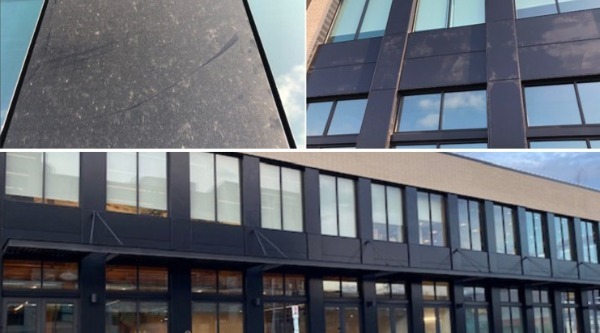UP TO THE MINUTE
Underlayment Materials for Protecting a Metal Roofing System

By RPS Metal Roofing and Siding, Inc.
Understand the similarities and differences between felt and synthetic underlayment materials to help your homeowner make the best decision under their metal roof.
The underlayment is the best prevention for water leaks on metal roof systems. It offers a barrier between the metal roofing and sheathing to keep water from getting into the roof deck. There are different materials for underlayment to choose from, but synthetic underlayment has recently become more popular. Understanding the benefits and disadvantages to each can help a contractor make an informed decision before installing a metal roof.
Traditional felt underlayment
Felt underlayment, commonly referred to as tar paper, has long been used as an underlayment material on roofs. Constructed using organic materials like wood pulp or recycled pieces and coated with asphalt to make it waterproof, felt has been in widespread use since the early 1900s and remains widely popular today.
Benefits of felt underlayment:
Cost effective: Felt underlayment is one of the more economical options on the market, making it an appealing option for those on a tight budget.
Easy installation: Installation is straightforward for felt underlayment roofers specializing in its application.
Effective vapor barrier: Felt underlayment is an efficient vapor barrier, keeping moisture out and protecting the roof deck from being compromised by moisture infiltration.
Most popular: Felt underlayment is the go-to choice for contractors and homeowners alike, readily available across markets worldwide.
Drawbacks of felt underlayment:
Not as durable: Felt underlayment may not be as long wearing and is susceptible to tears and punctures during installation or severe weather conditions, making it less than ideal for underlayment material.
Environmental issues: Since felt underlayment is made from petroleum products, it is less environmentally friendly than synthetic underlayments.
Not appropriate for high temperature environments: Due to asphalt coating softening in high temperature environments, felt underlayment may soften and crack over time.
Heavy roll of material: Felt underlayment comes in more extensive rolls than synthetic underlayment, making it more challenging to handle.
Synthetic underlayment
Synthetic underlayment is an emerging roofing material that has quickly grown increasingly popular over the last several years. Composed of manufactured materials like polypropylene or high density polyethene, synthetic underlayment provides superior protection from water penetration than its felt predecessors compared to metal, asphalt shingle, tile or slate roofs, making this versatile product an essential addition for any roofing project.
Synthetic underlayment can provide advantages:
Durability: Synthetic underlayment is considerably more durable than felt, meaning it will be less likely to tear or puncture during installation or extreme weather conditions.
Water resistant: Synthetic underlayment can more effectively prevent rainwater or snowmelt from penetrating the roof deck than felt underlayment, making it the better option for areas that experience heavy rainfall or snowfall.
Environment friendly: Since synthetic underlayment is made from recycled materials, it provides an eco-friendlier solution than felt underlayment.
Synthetic underlayment offers better value: Although it may cost more initially, its superior performance makes it a better value over time.
Lightweight rolls: Synthetic underlayment comes in lighter rolls for easier installation.
Contractors can walk on it: Synthetic underlayment can be safely walked on without incurring damage; felt underlayment could tear or puncture if trodden on, making it easier for contractors to complete their work without significant interruption. This enables them to complete projects more quickly.
Doing it right: Synthetic underlayment has proven itself more resilient to wrinkles and creases that often plague felt underlayments, meaning extra care must be taken during installation to ensure it is laid correctly without any defects.
Drawbacks of synthetic underlayment:
Pricey: Synthetic underlayment can be more expensive than felt underlayment, which may prove prohibitive to those on a tight budget.
Experience to install: Synthetic underlayment may not be as straightforward to install as felt underlayment; not all roofing contractors have experience using its application.
Vapor barrier concerns: While synthetic underlayment may be water resistant, it may not provide as effective a vapor barrier as felt underlayment; in such instances, an additional layer of felt underlayment should be needed to be installed as required to provide this function.
Not all manufacturers are equal: Not all synthetic underlays offer equal levels of protection. Before making a purchase, research must be performed into various manufacturers and their products to make an informed decision about who provides what level of coverage. Overall, it provides peace of mind when using felt underlayment.
Factors to keep in mind
Shorter- and long-term costs must also be factored into any purchase decision.
When it comes to selecting an underlayment material for a metal roof, both traditional felt underlayment and synthetic underlayment have their own set of advantages and disadvantages. While felt underlayment may be cost effective and easy to install, its durability may not match synthetic alternatives. In contrast, synthetic materials offer excellent water resistance but may cost more and be harder to install.
At the core of it all lies a homeowner’s budget, location and individual preferences – when making this choice, it is essential to factor in both short term and long-term costs when helping them make a decision. For instance, if they live in an area prone to heavy rainfall or snowfall, synthetic underlayment may be your best bet; otherwise, felt may provide more economical protection – when choosing any option, be mindful of both short-term costs and long-term ones!
Climate and weather conditions
When selecting an underlayment material, local climate and weather conditions should also be considered. For example, if your region is subject to extreme weather events such as hurricanes or tornadoes, opting for stronger synthetic underlayment might provide excellent protection from potential damage to the roof and home.
Environment factors
Additionally, it’s essential to consider the environmental impact of an underlayment choice.
While felt underlayment contains petroleum-based products that can harm the planet, synthetic underlayment crafted from recycled materials offers more sustainable solutions. If being ecoconscious is essential, artificial might be the better option.
Research building codes
Before selecting an underlayment, you must research local building codes and regulations.
Specific locations require certain types of underlayments for metal roofs; make sure you are informed of any additional needs before deciding.
Overall, both traditional felt and synthetic underlayment offer unique advantages regarding metal roofing. When deciding between them, it’s essential to carefully weigh all relevant factors according to a homeowner’s specific needs and preferences before making a final decision.
Original article source: RPS Metal Roofing and Siding, Inc.
Learn more about RPS Metal Roofing & Siding in their Coffee Shop Directory or visit www.rpsmetalroofing.com.





















Comments
Leave a Reply
Have an account? Login to leave a comment!
Sign In